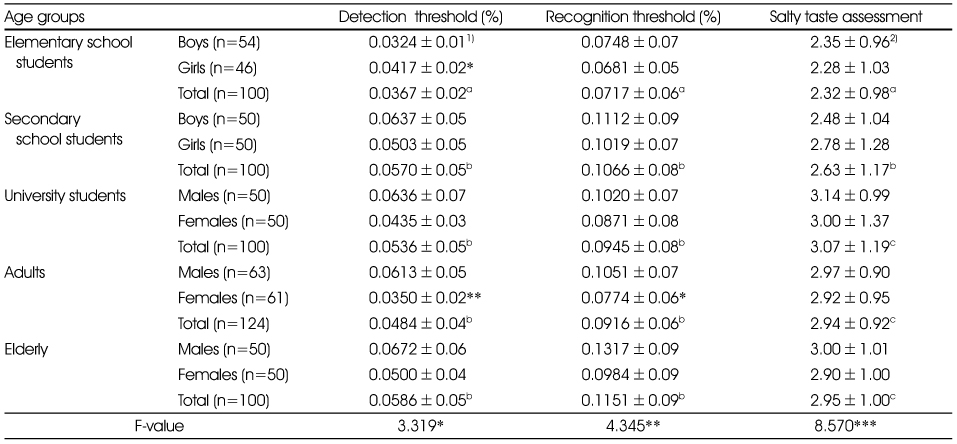References
1. Lee JH, Kim JS. Oral Physiology 3rd edth ed. Seoul: Shinkwang; 1989. p. 208–231.
2. Heft MW, Robinson ME. Age differences in orofacial sensory thresholds. J Dent Res 2010;89(10):1102–1105.
3. Fukunaga A, Uematsu H, Sugimoto K. Influences of aging on taste perception and oral somatic sensation. J Gerontol A Biol Sci Med Sci 2005;60(1):109–113.
4. Wardwell L, Chapman NK, Brewer MS. Effects of age, gender and chronic obstructive pulmonary disease on taste acuity. Int J Food Sci Nutr 2009;60Supple 6. :84–97.
5. Park SG, Kim SH, Kee WC, Choi JK. Changes in electrical taste threshold with age in Korea. J Oral Med Pain 1998;23(4):327–341.
6. Lee JW, Son HJ, Shin SH, Rhyu MR, Kim JY, Ye MK. Differences in taste thresholds according to sex and age groups in Korean. Korean J Otorhinoaryngol-Head Neck Surg 2014;57(10):692–697.
7. Lucas L, Riddell L, Liem G, Whitelock S, Keast R. The influence of sodium on liking and consumption of salty food. J Food Sci 2011;76(1):S72–S76.
8. Kim SH, Jang SY, Choi JK. Taste preference and whole-mouth taste threshold in a Korean population in the age of the 3rd decade. Korean J Oral Med 2003;28(4):413–426.
9. Yoon SC, Hur YK, Choi JK. Suprathreshold taste intensities for salt, sucrose, citric acid, and quinine HCl in elderly Korean women. Korean J Oral Med 2007;32(4):383–396.
10. Lee JW, Shin SH, Rhyu MR, Kim JY, Ye MK. The effect of aging on taste thresholds in Korean. Korean J Otorhinolaryngol-Head Neck Surg 2013;56(5):286–290.
11. Kim SH, Hur YK, Choi JK. Suprathreshold taste intensities for sucrose, NaCl, citric acid, and quinine HCl in young Koreans and the influence of sex, taste preference, and smoking. Korean J Oral Med 2005;30(2):149–162.
12. Shin EK, Lee HJ, Ahn MY, Lee YK. Study on the development and evaluation of validity of salty taste assessment tool. Korean J Nutr 2008;41(2):184–191.
13. Yoon JS, Lee YK, Kwon JS, Kim HK, Ahn MS. Developing nutrition education model for reducing sodium intake and evaluation II [internet]. Development application of salty taste assessment kit. Report of Korean Ministry of Food and Drug Safety 2011. cited 2011 Nov 11. Available from:
http://report.ndsl.kr/rep Detail.do?cn=TRKO201200007080.
14. Lee YK, Shin EK, Lee HJ. Salty taste assessment tool 2010 Patent 10-2007-0116957.
15. Lee YK, Jung YY, Jiang L. Development of computer program for salty taste assessment C-2012-010584 [internet] 2012. cited 2012 May 31. Available from:
http://www.saltdown.com.
16. International Organization and for Standardization. Sensory analysis - Methodology - Method of investigating sensitivity of taste 2nd edth ed. Geneva: 1991.
17. Kim HH, Shin EK, Lee HJ, Chun BY, Ahn MY, Lee YK. Evaluation of the effectiveness of a salt reduction program for employees. Korean J Nutr 2009;42(4):350–357.
18. Jiang L, Jung YY, Kim HS, Nam GS, Yun JS, Kim JW. A comparison of salty taste assessment, dietary attitude and dietary behavior among adult and senior women by region and by age in Korea. Korean J Community Nutr 2015;20(2):109–119.
19. Jiang L, Lee YK. Comparison of salty taste assessment and highsalt dietary behaviors among university students and Chinese students in Daegu, South Korea and university students in Shenyang, China. Korean J Community Nutr 2013;18(6):555–564.
20. Jung YY, Shin EK, Lee HJ, Lee NH, Chun BY, Ann MY. Development and evaluation of a nutrition education program on sodium reduction in elementary school students. Korean J Community Nutr 2009;14(6):746–755.
21. Kim HH, Jung YY, Lee YK. A Comparison of salty taste assessments and dietary attitudes and dietary behaviors associated with high-salt diets in four regions in Korea. Korean J Community Nutr 2012;17(1):38–48.
22. Verma P, Mittal S, Ghildiyal A, Chaudhary L, Mahajan KK. Salt preference: age and sex related variability. Indian J Physiol Pharmacol 2007;51(1):91–95.
23. Frye CA, Demolar GL. Menstrual cycle and sex differences influence salt preference. Physiol Behav 1994;55(1):193–197.
24. Suliburska J, Duda G, Pupek-Musialik D. Effect of tobacco smoking on taste sensitivity in adults. Przegl Lek 2004;61(10):1174–1176.
25. Ye MK, Han BD, Lee JW, Rhyu MR, Hyun DS, Shin SH. Relationship between taste genotype and smoking and alcohol intake. Korean J Otorhinolaryngol-Head Neck Surg 2011;54(12):847–852.
26. Kim SH, Hur YK, Choi JK. Suprathreshold taste intensities for sucrose, NaCl, citric acid, and quinine HCl in young Koreans and the influence of sex, taste preference, and smoking. J Korean Acad Oral Med 2005;30(2):149–162.
27. Kim HH, Jung YY, Lee YK. A Comparison of salty taste assessments and dietary attitudes and dietary behaviors associated with high-salt diets in four regions in Korea. Korean J Community Nutr 2012;17(1):38–48.






